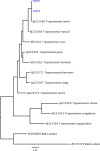Historical mammal extinction on Christmas Island (Indian Ocean) correlates with introduced infectious disease
- PMID: 18985148
- PMCID: PMC2572834
- DOI: 10.1371/journal.pone.0003602
Historical mammal extinction on Christmas Island (Indian Ocean) correlates with introduced infectious disease
Erratum in
- PLoS ONE. 2009;4(1). doi: doi.org/10.1371/annotation/9fbe9687-682e-4010-97e4-139b33343d34. Ball, Stanley J [added]
Abstract
It is now widely accepted that novel infectious disease can be a leading cause of serious population decline and even outright extinction in some invertebrate and vertebrate groups (e.g., amphibians). In the case of mammals, however, there are still no well-corroborated instances of such diseases having caused or significantly contributed to the complete collapse of species. A case in point is the extinction of the endemic Christmas Island rat (Rattus macleari): although it has been argued that its disappearance ca. AD 1900 may have been partly or wholly caused by a pathogenic trypanosome carried by fleas hosted on recently-introduced black rats (Rattus rattus), no decisive evidence for this scenario has ever been adduced. Using ancient DNA methods on samples from museum specimens of these rodents collected during the extinction window (AD 1888-1908), we were able to resolve unambiguously sequence evidence of murid trypanosomes in both endemic and invasive rats. Importantly, endemic rats collected prior to the introduction of black rats were devoid of trypanosome signal. Hybridization between endemic and black rats was also previously hypothesized, but we found no evidence of this in examined specimens, and conclude that hybridization cannot account for the disappearance of the endemic species. This is the first molecular evidence for a pathogen emerging in a naïve mammal species immediately prior to its final collapse.
Conflict of interest statement
Figures



References
-
- MacPhee RDE, Marx PA. The 40,000-year plague: Humans, hyperdisease, and first-contact extinctions. In: Goodman SM, Patterson BD, editors. Natural change and human impact in Madagascar. Washington, DC: Smithsonian Institution Press; 1997. pp. 169–217.
-
- Lyons SK, Smith FA, Wagner PJ, White EP, Brown JH. Was a ‘hyperdisease’ responsible for the late Pleistocene megafaunal extinction? Ecology Letters. 2004;7:859–868.
-
- Andrews CW. A monograph of Christmas Island (Indian Ocean) London: British Museum (Natural History); 1900.
-
- Thomas O. Report on a zoological collection made by the officers of H.M. “Flying Fish” at Christmas Island, Indian Ocean. I. Mammalia. Proceedings of the Zoological Society of London. 1887;1887:511–514.
Publication types
MeSH terms
Substances
LinkOut - more resources
Full Text Sources
Other Literature Sources

